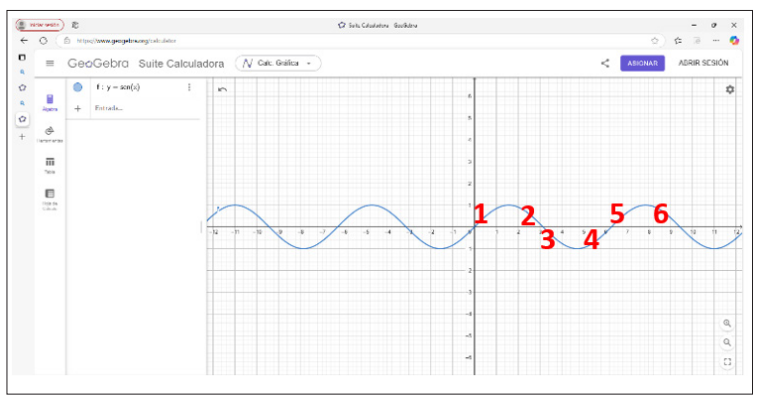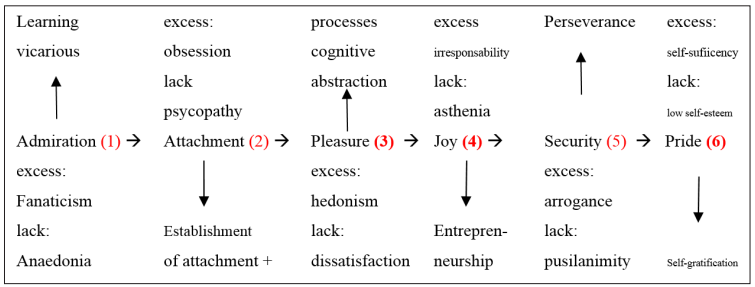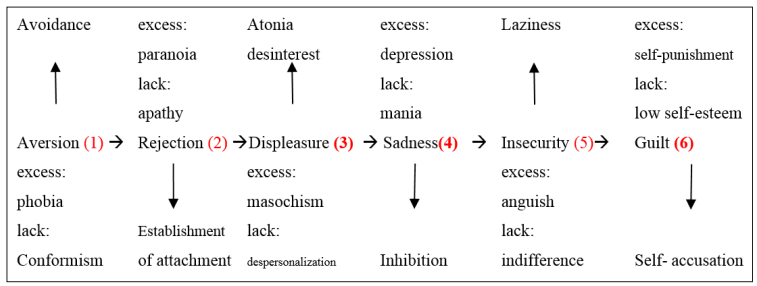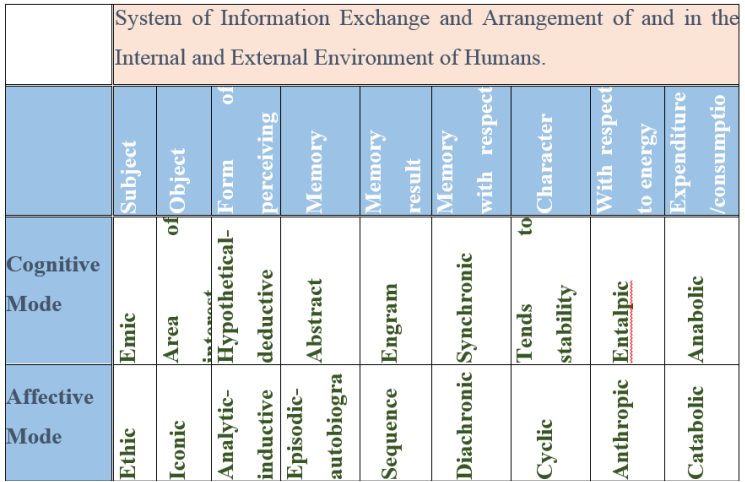Author(s): Ricardo Morgado Giraldo
In this article we begin by exposing the methodological option, chosen on this occasion in the study of human affectivity; that is, the systemic one. Although, as we said in our previous article, we do not refer to interpersonal relationships as a system or as interaction, we refer to the fact that the mechanisms of the affective way of perceiving and conceiving the world can and should we contemplate as a system. That is to say, our methodology of systemic and intrapersonal. Once we have established which systemic methodology we employ, we delve into the cyclical nature of the affective way of knowing, its sequentially and the type of memory on which it is based.
Finally, we analyze the peculiarities of each of the stages of the affective cycle, its dysfunctionalities and possible ways to correct them. In other words, we see affectivity from the point of view of basic psychology, not from that of social or clinical psychology; although we perceive that, with this approach, a multitude of therapeutic or didactic possibilities open up, which will have to be developed.
If we start from a systemic approach: any biological system, as well as non-biological systems, tends to equilibrium [1]. In the case of psychopathologies, all descriptions of mental disorders must start from a comparison with the functioning of a balanced mental system. In the case of the affective system, it happens as with any other system: in order to understand it, we should first have described and understood it thanks to an ideal or paradigmatic model, which represents a sufficient number of various moments or situations of that system. All them, related to each other by that model, not for statistical (normative) reasons, but by a logical which, almost, becomes qualitative.
However, this logical cannot be qualitative, because if it were, it would reach such a degree of stability that it would represent only one case; and not only would it cease to be a system, but we could consider it a rigid structure, without vectors. That is, an impossible construct, because we already know that structures are systems and have vectors.
Moreover, if it represents only one case, it cannot be a model either, because if there is a model, there must be at least two cases, which compare and recognize each other, in a certain sense, as a unit before other cases; which, to complicate things further, in order to be considered different from those hypothetical two, must have been previously compared to another previous model, This last, leads the reasoning to absurdity; since the existence of that hypothetical model would make it unnecessary to search for the model that would explain the connection and relate the two hypothetical cases we have been talking about to each other.
Thus, largely following these premises, in our previous article on affectivity, we tried to describe an affective system that would respond to this non-statistical normality; that, although valid to explain most cases or situations, would not rely on frequencies and percentages to do so, but would start from the principle of necessity, according to which one event must necessarily be followed by another, so that the first and the second justify each other and help to configure the system.
Thus, in this work, we use the systemic approach as the main tool of analysis, but of a system that is part of the affective universe of each individual. Among other reasons for doing this, there is the need to take the focus out of social psychology to study emotions and human affectivity in general; to place this focus -with the help of phenomenology and individual experience- in the systemic and vectorial perspective.
To achieve the latter, we found it extremely useful to represent graphically the processes we were trying to explain, and thanks to this, we first observed that certain situations explained each other, according to a sequence, which was repeated each time we observed it, in the same order; so we came to think -from these observations- that it was a cyclical system.
Secondly, we tried to represent how the axis of that cycle made the whole cyclic system rotate. For this reason, we used a flow diagram, which explained how the affective bond acted to endow itself with energy and, at the same time, it make the whole affective system rotate.
Summarizing, so far, we have come to the conclusion that the system is cyclical, and that the energy that makes it turn is the affective bond (negative or positive).
If we consider that sequence in a linear way, we can see that these sequences are:
Positive Attachment: Admiration → Bonding → Pleasure → Joy → Security →Pride.
Negative Attachment: Contempt → Rejection → Displeasure → Sadness → Insecurity → Guilt.
Let us remember that this cycle, we suppose, generates an oscillatory movement; which, if we continue with the simile, has peaks and valleys of energy. Thus, Admiration, Pleasure and Security, generate catabolic or enthalpic processes, energy consumers; and Bonding, Joy and Pride generate anabolic or enthalpic processes, energy savers.
Something similar could happen with the negative bond.
We have already pointed out that this oscillatory motion, as physicists tell us, is governed by the Unfortunately, we still have to resort to this statistical term. expression f(x)= sin (x), which is taken to its graphic expression

If we start from x=0, i.e. from a conventional moment when the cycle is at a standstill, we must interpret the whole graph from the abscissa axis. As the radians are drawing the curve, we can intuit that, in the case of the positive link, the Admiration (i.e. the moment in which EGO considers the object as valuable (put in value), the curve is ascending and releasing or spending energy. What kind of energy? obviously cerebral, and this will be deployed because of the expenditure of the same, which occurs during the chemical and electrical conduction.
At this point, it is worth asking ourselves if this expenditure of energy is the same in all chaos. It seems obvious to us that it is not: there are “objects” that we admire a lot, and others that we do not; or there are objects that we admire a lot, but because we consider them unattainable, we discard them, and they leave our area of interest.
No matter how theoretical an investigation may be, there always comes a time to justify it and to look for its usefulness, otherwise we would fall into the Neoplatonism of the superiority of ideas over facts. Let us try to understand what happens during the cycle we have been talking about. We will rely on the following graph for this analysis.
At moment 1, when any object stands out from our perceptual environment, and we begin to place value on it, it can lead us by excess to finalization (especially if that object is ideas, beliefs or physical persons), or to the absence of any affective bond whatsoever. In the case of the desirable, this admiration leads to the establishment of stable positive feelings towards the object in question: bonding. The upward arrow represents an increase of (psychic) energy at this moment of the cycle.
In moment 2, the excess of energy used often leads to crystallization and lack of ambiguity, which turns the desired object into an anchor and an obsessive ballast that prevents the normal development of the EGO; when the EGO is in a situation of lack, the object is a toy that is manipulated or destroyed without limitation.
In moment 3, the benefits of the energy used for to establish the attachment, a relatively neutral state of mind is created, which favours abstract and complex analysis processes.
At moment 4, everything seems favourable and is undervalued, in the face of the possibility of failure.
In moment 5, the benefits of the link make it useful to maintain it and this implies the use of energy, perseverance and proactivity. The excess, in this case, is pride, and in this case the object is valued because it is pro-owned; whereas, in the case of pride, it is undervalued, for the same reason, in the case of pusillanimity.
At time 6, the two extremes will be self-sufficiency and low self- esteem, and, if all goes well, it will continue and the cycle will be reinforced.

Perhaps one of the clearest allusions to what negative effects are (as they are traditionally perceived, not only in Western society, but in many others), is in a quote by Marina, when evoking Thomas Aquinas, “[...] is in a reference that Marina makes to Thomas Aquinas, “When Thomas Aquinas makes his map of the passions, he divides them into two groups: the concupiscible passions and the irascible passions” [2]. We are not going to make this comparison with vices or transgressions; on the contrary, we use the expression negative in the sense that they are directed at or linked to both desired and undesired objects. Thus, we will study them in the same conditions and category with which we approach the positive ones, that is to say, those that imply a attachment with what is desired.
We will now describe what, in our opinion, happens with the negative links to “objects”. We say then that in the case of the negative bonds:
The moment 1 is characterized by effort and strategies aimed at the avoidance of something unwanted. When that effort goes to the extreme and reaches a very fixed stereotype of the object. In the case of deprivation, we find chronic victimization.
Moment 2 is identifiable when there are no oscillations in the rejection of the unwanted object, the excess reaching the point of distancing from reality the threats perceived from it, concluding all this in paranoia; with the lack. With lack comes learned helplessness and apathy.
Moment 3, the lack of effectiveness of the rejection, leads to the declared displeasure, which makes one show disinterest or indifference. If there is a fixation on the displeasure, we can relate it to masochism, and if the reaction is imperceptible, to depersonalization.
In moment 4, sadness (which may be due to an undesired negative bond, as well as to the loss of what is desired). In this case, it is clear that excess is one of the components (not the only one) of depression. Lack, accordingly, could be the cause of over- compensation related to mania (we see, with increasing clarity, the tendency to re-solve grief as quickly as possible, as it happens when we are faced with an undesired situation that is deemed unnecessary) [3].
Moment 5 has been characterized by insecurity, whose most visible aspect may be laziness or negatively unconcerned behaviour. We believe that its excess leads to anguish and its lack to indifference.
Finally, moment 6 leads us to guilt, which seems to be the most corrosive of mental states, leading to self-punishment and self- toxic behaviors; when it acts, learned helplessness is natural. For this reason, negative attachments must be solved with solvency, as they often prove to be detrimental to EGO.

This construct seems to be useful, not only to represent what happens with the affections, but also to understand them better.
On several occasions, we have praised the value of Plutchik's model of emotions [4-6]. We believe with him, that “I believe that a scientific and therapeutically useful understanding of emotions is possible” [7]. However, we are not with him when he says: “The effect of the emotional state is to create an interaction between the individual and the event or stimulus that precipitated the emotion.” Since that sentence seems to say that emotion is basically a reaction, thus giving it a much less relevant role than we see.
So, Plutchik's model is for us a great source of inspiration and offers us important reflections, some of them useful for our model. However, it is a structural model, although it tries to explain how emotions interact with each other. This seems contradictory to us, because it is impossible to represent the interaction with a static model, so we resort in our work to a systemic model that is represented with vectors, what we have been calling “affective way of processing information and acting”.
In other aspects, due to the need to distinguish our ideas about affectivity from the preceding ones: we have to say that the models used so far by researchers and scientists are models strongly influenced by localizationism. But current research speaks mainly of brain structures (such as the limbic system, the thalamus, the amygdala...). However, current research speaks mainly of types of nerve transmission, i.e. electrical transmission, through the numerous types of ion channels, and chemical transmission, based in turn on the also numerous neurotransmitters and neurohormones, which are also very diverse [8-11]. The two types of nervous transmission now mentioned describe a biological universe of our brain in continuous movement and loss and search for equilibrium, reminiscent of the holographic hypothesis of Martín Ramírez and Pribram [12]. Although these biological models, although promising in explaining the affective world, are not sufficient to objectively relate the biological and psychological levels of affectivity, without falling into reductionism. For our part, we continue to try to describe the affective mode and its repercussions in applied science.
A question that arises when setting out our model
What if it were not a question of structures, but of vectors? What if we should also consider two types of vectors?
We have spoken of a system from the beginning; and this is evidently because we suspect that we are dealing with a system in which we have identified two modes, for the moment, the cognitive mode and the affective mode.
In order to try to explain the relationship between all these concepts, of course we start from the idea that we are talking about two (or perhaps more) levels of reading reality; levels that are superimposed (without necessarily implying hierarchy), which implies that one must be a precondition for the other, although the two are equipotent.
We can qualify this equipotentiality by saying that one of them is an emergent of the other; that is to say, the psychological is an emergent of the biological, although we can say that it is still biological, without ceasing to be psychological.
At this point, it seems that we should be clear on the matter; but nothing could be further from the truth, because the parallelism established between: biological/hardware and psychological/ software gives us the feeling that it is simplistic, since we may be building one construct on another construct.
To find a way out of this dilemma, we consider that we are dealing with a special system in which its vectors are not as simple as the structure of a building. We want to see that, in this system; its vectors not only vary in intensity, direction and sense, but are qualitatively different, so that the forces they unleash are not comparable. We refer to those forces that in the nervous system unchain all that combination of forces or electromagnetic fields, which constitute psychic life. These vectors act, it is true, at the cellular level, and it is true that we can assimilate them to the microchips of the hardware of a computer, but their complexity is much higher, since there are not only two types of transmission (electrical and chemical), while in the microcircuits it is only electrical.
It should also be noted, that the complexity of the ionic channels far exceeds that of the electrical connections, which can be counted not only in hundreds, but in thousands, and that, while electrons circulate in an electrical circuit (all of them equal to each other); in the electrical transmission of cells, anions and cations are different from each other when it comes to function, since they come from ions that are different and have different behaviour.
Not only that, but the wide variety of neurotransmitters that make up the chemical synapse act in interaction with electrical transmission. Although this is not the objective of this work, we do want to show that there are synchronous or harmonic movements between the biological and psychological levels, although some works, such as that of García and Arandia, do not seem to renounce this [13-15].
What aspects of the cyclic model of affectivity may be relevant? Returning to the behaviour of the sine curve, we can summarize it with the following table:

Therapeutic Strategies
In accordance with what has been said so far, the therapeutic strategies we propose are in line with the systemic approach, emphasizing the importance of homeostasis and the phenomenological perspective.
All this understood as a multitude of cycles, on all of which it will not be possible, nor useful, to intervene. We then ask ourselves: what happens when a cycle ends? We will only be able to answer this question when:
Nevertheless, we venture to think that the cycle tends to follow its inertia, until some circumstance breaks it.
Finally, reviewing again the process that we have glimpsed, when we have analysed the cycle, with the help of the Phenomenology, we propose that
